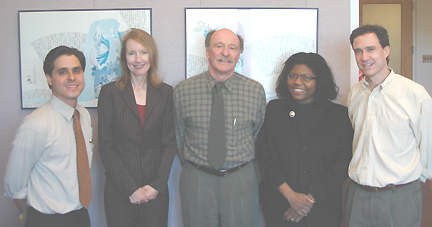
| T H E N I H C A T A L Y S T | M A Y – J U N E 2007 |
|
|
|
OFFICE
OF THE
NIH OMBUDSMAN: BASIC AND
APPLIED
PROBLEM SOLVING
|
|
 |
|
Here
to Help:
Ombudsman Howard Gadlin (center), flanked by (left to right) Guillermo
Aviles-Mendoza, Kathleen Moore, Linda Brothers, and Kevin Jessar
|
Like many of the denizens here at NIH, Howard Gadlin advocates for preventive medicine. His five-member staff handles about 600 cases a year, and often he laments that he could have resolved some of his visitors’ problems better if only they would have come to him sooner.
Gadlin is not a medical doctor, though. He’s the NIH Ombudsman.
Gadlin’s office, the Center for Cooperative Resolution, is open to NIH staff at all levels for nearly any kind of work-related problem. And more than 200 researchers take advantage of this service each year. Issues range from simple clarification of policies, to unmanageable interpersonal conflicts, to scientific disputes involving authorship or differences interpreting data—all handled confidentially. His office offers facilitated conversation, shuttle diplomacy, or sometimes just sage advice.
"Some people are apologetic about coming in," Gadlin said. "If it seems important to you, then we’re interested in helping you resolve it." And the sooner his team can get involved, the better, Gadlin said, because problems can "intensify exponentially."
Gadlin is the first full-time, center-wide ombudsman at NIH, arriving here nine years ago after directing the ombudsman’s office at the University of California, Los Angeles. He holds a doctorate in experimental psychology and understands the laboratory environment, a former workplace for many years. So he’s not surprised by his office’s own statistics revealing that cases involving scientists, while comprising about 40 percent of the caseload, encompass about 60 percent of his time.
"Scientists tend to think that a problem will eventually clear up, like a head cold," he said. "The more [a problem] continues, the more self-fulfilling it is."
In a complex organization like NIH, Gadlin said, there are many issues that fall outside the purview of formal grievance and dispute-resolution systems. Common problems entail staff-management interaction, performance appraisals, interpersonal misunderstandings, and awkward office or lab situations, such as noise or messiness. Managers make the most serious errors when they are certain they are correct and forget about procedures, Gadlin said. This leaves them with little negotiating strength in the long run.
Much of Office of the Ombudsman’s energy is spent coaching scientists on how to manage conflict—to "minimize its destructive element," Gadlin said, but not to simply suppress it, because sometimes a certain level of conflict is needed in the scientific process.
Gadlin’s staff—Kevin Jessar, Kathleen Moore, Linda Brothers, and Guillermo Aviles-Mendoza—offer a range of expertise in counseling, employee relations, and law. They have assisted NIHers who are unclear about NIH policies, who need an independent facilitator, who feel they have been treated unfairly, who want coaching about constructive ways to handle a difficult situation, or who have concerns about mentoring, authorship, resources, or intellectual property rights.
Sometimes they can facilitate dialogue. Other times, when it is not wise to bring two people face to face, the staff may shuttle between the quarreling parties, as is done in a bitter divorce. Conflicts are sometimes resolved by parting and not by group hug.
In way of preventive medicine, the Office of the Ombudsman can identify potential problems, such as internal practices that can lead to conflict. The office provides training and presentations in this regard. Particularly for the scientific staff, the office has developed customized dispute-resolution mechanisms. These include a process called partnering, in which scientific collaborators develop an agreement about a project upfront to clarify roles and expectations.
Should individuals bring a problem to the office for which there is actually a more appropriate resource—for instance, the NIH Employee Assistance Program for family or other nonwork concerns—they will be channeled in the right direction.
The office does have its limitations: Its representatives cannot serve as an advocate, conduct investigations, make policy decisions, or determine rights. It is best to think of the ombudsman’s office, Gadlin said, as a means to develop and understand ways to resolve problems.
And despite the pleasant working environment at NIH, problems are inevitable. "When you have highly creative people working within a government bureaucracy, issues arise," Gadlin said.
A two-foot
inflatable replica of the well-known character from Edvard Munch’s Scream
graces Gadlin’s desk, perhaps to reflect the kind of reaction the ombudsman’s
office was created to avoid.
![]()
For a full list of ombudsman office services and contact information, see the website.
| Speedy Ethics Course for Summer Interns |
|
A valuable (and required) course for NIH summer interns is a web-based training module on ethics, called the Ethics and Scientific Research Study Guide. The course, humorous at times, walks the student through temptations of scientific dishonesty. Some examples are obvious; others, such as the right of authorship, lie in a gray area. The course takes only 15 minutes and is available at this website. |